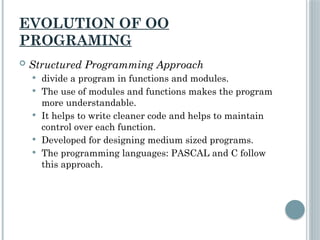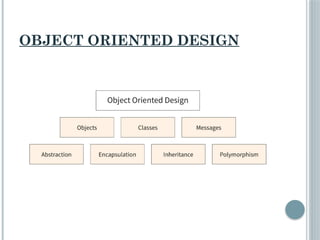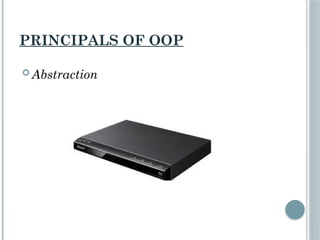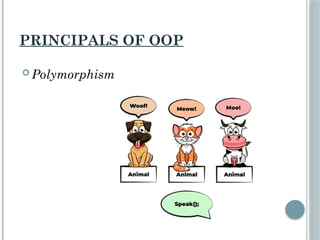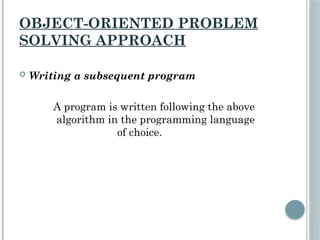basics of c++ object oriented programming l anguage
- 2. REFERENCE MATERIAL Textbook: C How to program by Paul Detiel and Harvey Detial, Prentice Hall; 10th edition (March 4, 2017) Reference Books: The C++ Programming Language, 4th Edition by Bjarne Stroustrup The C++ Programming Language, 4th Edition 4th Edition by Bjarne Stroustrup, Adison-Wesley Professional Jumping into C++ by Alex Allian, Cprograming.com
- 3. WHAT IS OOP? Object Oriented Programming is a programming technique in which programs are written on basis of objects. Object is a collection of data and function Object represent a person, place or thing in real world. In OOP data and all possible function on data are grouped together.
- 4. WHAT IS OOP? Object Oriented Programming is a programming style that is associated with the concept of class, Objects and various other concepts revolving around these two, like inheritance, polymorphism, abstraction, encapsulation.
- 5. EXAMPLE A fork is an object with properties a number of prongs its size material (made of plastic or metal), etc. Behavior and functions of a fork include Shredding Squashing Making design Eating. 3
- 6. EXAMPLE Fork
- 7. WHY OOP IS NECESSARY ? The OOP (Object Oriented Programming) approach is most commonly used approach now a days. OOP is being used for designing large and complex applications. The earlier approaches to programming were not that good, and there were several limitations as well.
- 8. EVOLUTION OF OO PROGRAMING These programming approaches have been passing through revolutionary phases just like computer hardware. Machine Language Monolithic Approach Procedural Approach Structural Approach OOP
- 9. EVOLUTION OF OO PROGRAMING Machine Language for designing small and simple programs Monolithic Programming Approach the program consists of sequence of statements that modify data. code is duplicated each time because there is no support for the function. data is not fully protected as it can be accessed from any portion of the program. programming languages include ASSEMBLY and BASIC.
- 10. EVOLUTION OF OO PROGRAMING Procedural Programming Approach Program is divided into functions that perform a specific task. Data is global and all the functions can access the global data. This approach avoids repetition of code which is the main drawback of Monolithic Approach. Enabled us to write larger and hundred lines of code
- 11. EVOLUTION OF OO PROGRAMING Structured Programming Approach divide a program in functions and modules. The use of modules and functions makes the program more understandable. It helps to write cleaner code and helps to maintain control over each function. Developed for designing medium sized programs. The programming languages: PASCAL and C follow this approach.
- 12. EVOLUTION OF OO PROGRAMING Object Oriented Programming Approach The basic principal of the OOP approach is to combine both data and functions so that both can operate into a single unit. Such a unit is called an Object. This approach secures data also. Now a days this approach is used mostly in applications. The programming languages: C++ and JAVA follow this approach.
- 13. OBJECT ORIENTED DESIGN Object-oriented design (OOD) is the process of creating a software system or application utilizing an object-oriented model. This technique permits the creation of a software solution based on object notion. OOD is an implementation of the object-oriented programming (OOP) paradigm.
- 14. OBJECT ORIENTED DESIGN In the object-oriented design method, the system is considered a collection of objects (i.e., entities). The state is shared among the objects, and each object is responsible for its own state data. Similar objects form a class. In other words, every object belongs to a class.
- 16. OBJECT ORIENTED DESIGN Objects An Object can be defined as an entity that has a state and behavior, or in other words, anything that exists physically in the world is called an object. It can represent a dog, a person, a table, etc. An object means the combination of data and programs, which further represent an entity.
- 17. OBJECT ORIENTED DESIGN Classes Class can be defined as a blueprint of the individual object, attribute and method. Method Function that describe behavior of class Attribute Define in class and represents state of object.
- 18. OBJECT ORIENTED DESIGN Example of class and object
- 19. OBJECT ORIENTED DESIGN Example of class, method and attributes
- 20. OBJECT ORIENTED DESIGN Message Objects communicate by passing messages. Messages contain the name of the requested operation, and any other action required to complete the function. Messages are frequently implemented through function calls.
- 21. PRINCIPALS OF OOP Encapsulation Abstraction Inheritance Polymorphism
- 22. PRINCIPALS OF OOP Encapsulation The wrapping up of data and functions together in a single unit is known as encapsulation. All properties and methods of an object are kept private and save from other object. Encapsulation makes the data non-accessible to the outside world.
- 23. PRINCIPALS OF OOP Encapsulation
- 24. PRINCIPALS OF OOP Abstraction Abstraction helps in the data hiding process. It helps in displaying the essential features without showing the details or the functionality to the user. It avoids unnecessary information or irrelevant details and shows only that specific part which the user wants to see.
- 25. PRINCIPALS OF OOP Abstraction
- 26. PRINCIPALS OF OOP Inheritance Inheritance is the process in which two classes have an is-a relationship among each other and objects of one class acquire properties and features of the other class. The class which inherits the features is known as the child class, and the class whose features it inherited is called the parent class. For example, Class Vehicle is the parent class, and Class Bus, Car, and Bike are child classes.
- 27. PRINCIPALS OF OOP Inheritance
- 28. PRINCIPALS OF OOP Polymorphism Polymorphism means many forms. It is a feature that provides a function or an operator with more than one definition. It can be implemented using function overloading, operator overload, function overriding, virtual function.
- 29. PRINCIPALS OF OOP Polymorphism
- 30. OBJECT-ORIENTED PROBLEM SOLVING APPROACH Object-oriented problem solving approach is very similar to the way a human solves daily problems. It consists of identifying objects and how to use these objects in the correct sequence to solve the problem.
- 31. OBJECT-ORIENTED PROBLEM SOLVING APPROACH In other words, object-oriented problem solving can consist of designing objects whose behavior solves a specific problem. A message to an object causes it to perform its operations and solve its part of the problem.
- 32. OBJECT-ORIENTED PROBLEM SOLVING APPROACH The object-oriented problem solving approach, in general, can be divided into following steps. They are: 1. Understanding the problem 2. Formulating a model 3. Developing an algorithm 4. Writing a subsequent program 5. Testing and improving the program 6. Evaluating the solution.
- 33. OBJECT-ORIENTED PROBLEM SOLVING APPROACH Understanding the problem The question has asked to find the mean of all the given grades of a student
- 34. OBJECT-ORIENTED PROBLEM SOLVING APPROACH Formulating a model Average = grade1 + grade2 + …. + gradeN number of records
- 35. OBJECT-ORIENTED PROBLEM SOLVING APPROACH Developing an algorithm grades_array = grades, sum=0 for grade in grade array add grades -> sum average <- sum / length(grades_array)
- 36. OBJECT-ORIENTED PROBLEM SOLVING APPROACH Writing a subsequent program A program is written following the above algorithm in the programming language of choice.
- 37. OBJECT-ORIENTED PROBLEM SOLVING APPROACH Testing and improving the program The program is tested against all kinds of data including but not limited to corner cases that may break the algorithm such as the length of the array being returned as 0.
- 38. OBJECT-ORIENTED PROBLEM SOLVING APPROACH Evaluating the solution The solution is evaluated and checked whether the output is correct or not.
- 39. PROS OF OOP Secure Reusability High productivity Reduce redundancy Low-cost development Easy to maintain and modify Allows for parallel development.
- 40. DRAWBACKS OF OOP Complexity Hardware Constraints Size is larger than other programs It required a lot of effort to create It is slower than other programs It is not suitable for some sorts of problems It takes time to get used to it.










